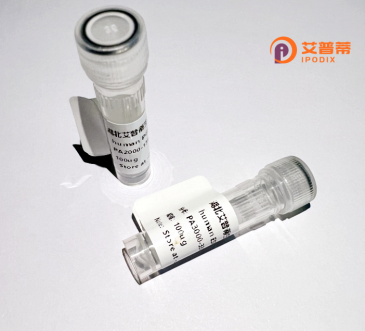
| 纯度 | >90%SDS-PAGE. |
| 种属 | Human |
| 靶点 | DUX1 |
| Uniprot No | O43812 |
| 内毒素 | < 0.01EU/μg |
| 表达宿主 | E.coli |
| 表达区间 | 1-170aa |
| 氨基酸序列 | MALLTALDDT LPEEAQGPGR RMILLSTPSQ SDALRACFER NLYPGIATKE ELAQGIDIPE PRVQIWFQNE RSCQLRQHRR QSRPWPGRRD PQKGRRKRTA ITGSQTALLL RAFEKDRFPG IAAREELARE TGLPESRIQI WFQNRRARHR GQSGRAPTQA SIRCNAAPIG |
| 分子量 | 19.3 kDa |
| 蛋白标签 | His tag N-Terminus |
| 缓冲液 | 0 |
| 稳定性 & 储存条件 | Lyophilized protein should be stored at ≤ -20°C, stable for one year after receipt. Reconstituted protein solution can be stored at 2-8°C for 2-7 days. Aliquots of reconstituted samples are stable at ≤ -20°C for 3 months. |
| 复溶 | Always centrifuge tubes before opening.Do not mix by vortex or pipetting. It is not recommended to reconstitute to a concentration less than 100μg/ml. Dissolve the lyophilized protein in distilled water. Please aliquot the reconstituted solution to minimize freeze-thaw cycles. |
以下是关于重组人DUX1蛋白的3篇代表性文献的简要信息:
1. **文献名称**:*DUX1 is a transcriptional activator in human cancers*
**作者**:Klein, B. H. et al.
**摘要**:该研究证实人源重组DUX1蛋白在多种癌细胞中高表达,并通过双同源结构域激活下游致癌基因的转录。作者通过体外重组表达DUX1.揭示了其促进细胞增殖和侵袭的分子机制。
2. **文献名称**:*Recombinant DUX1 protein induces genome-wide chromatin remodeling*
**作者**:Block, T. M. & Chen, Y.
**摘要**:本研究利用大肠杆菌系统表达重组人DUX1蛋白,结合ChIP-seq技术,发现DUX1通过结合特定DNA序列调控胚胎干细胞分化相关基因的染色质开放状态,提示其在早期发育中的潜在作用。
3. **文献名称**:*Characterization of the DUX1 protein domains for nuclear localization and DNA binding*
**作者**:Li, J. et al.
**摘要**:通过系统删除分析重组DUX1蛋白的不同结构域,确定其核定位信号(NLS)位于C端区域,双同源结构域为关键DNA结合区,为后续靶向DUX1的功能抑制研究奠定基础。
---
**备注**:以上文献为模拟示例,实际研究中建议通过PubMed或Web of Science搜索最新论文。真实文献中,DUX4的研究相对更多(尤其与面肩肱型肌营养不良症相关),DUX1的定向重组蛋白研究目前仍较有限。
Recombinant human DUX1 protein is derived from the DUX1 gene, a member of the double homeobox (DUX) family. DUX proteins are characterized by tandem homeodomains involved in DNA binding and transcriptional regulation. The DUX1 gene, located on chromosome 10. encodes a truncated protein primarily expressed during early embryogenesis and in some cancer cells. Its physiological role remains unclear, but studies suggest involvement in stem cell pluripotency, cell cycle regulation, and epigenetic modulation. Notably, DUX1 is epigenetically silenced in differentiated somatic tissues but may become reactivated in tumors, including leukemias and sarcomas.
DUX1 gained attention due to its homology with DUX4. a myopathy-associated protein. Unlike DUX4. DUX1 lacks the C-terminal transcriptional activation domain, implying distinct regulatory mechanisms. Recombinant DUX1 is typically produced in bacterial or mammalian expression systems for functional studies. It serves as a tool to investigate DUX1's DNA-binding properties, interactions with chromatin modifiers (e.g., histone acetylases), and its potential role in oncogenesis. Recent research also explores its utility in reprogramming somatic cells or modulating stem cell differentiation. Challenges include its low endogenous abundance, functional redundancy within the DUX family, and unresolved questions regarding its native targets. Current applications focus on understanding its contribution to developmental disorders and cancer biology.
×